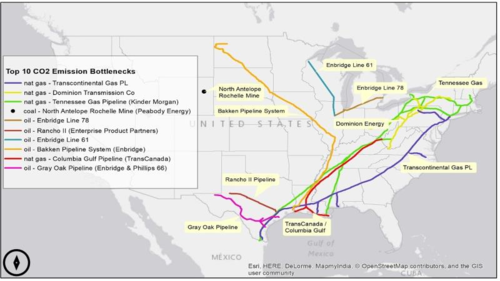J.M.Pearce (talk | contribs) m (→Source) |
J.M.Pearce (talk | contribs) m (→See Also) |
||
| Line 26: | Line 26: | ||
---- | ---- | ||
Follow up | Follow up | ||
* http://blog.ucsusa.org/elliott-negin/will-new-scientific-breakthroughs-pave-the-way-for-more-climate-related-lawsuits | |||
* Heede, R. (2014). Tracing anthropogenic carbon dioxide and methane emissions to fossil fuel and cement producers, 1854–2010. Climatic Change, 122(1-2), 229-241. https://link.springer.com/article/10.1007/s10584-013-0986-y | |||
Revision as of 11:37, 1 August 2020

Source
- Alexis S. Pascaris and Joshua M. Pearce U.S. Greenhouse Gas Emissions Bottlenecks: Prioritization of Targets for Climate Liability. Energies 13(15), 2020, 3932; https://doi.org/10.3390/en13153932 open access
Abstract
Due to market failures that allow uncompensated negative externalities from burning fossil fuels, there has been a growing call for climate change-related litigation targeting polluting companies. To determine the most intensive carbon dioxide (CO2)-emitting facilities in order prioritize liability for climate lawsuits, and risk mitigation strategies for identified companies as well as their insurers and investors, two methods are compared: (1) the conventional point-source method and (2) the proposed bottleneck method, which considers all emissions that a facility enables rather than only what it emits. Results indicate that the top ten CO2 emission bottlenecks in the U.S. are predominantly oil (47%) and natural gas (44%) pipelines. Compared to traditional point-source emissions methods, this study has demonstrated that a comprehensive bottleneck calculation is more effective. By employing an all-inclusive approach to calculating a polluting entity’s CO2 emissions, legal actions may be more accurately focused on major polluters, and these companies may preemptively mitigate their pollution to curb vulnerability to litigation and risk. The bottleneck methodology reveals the discrete link in the chain of the fossil-fuel lifecycle that is responsible for the largest amount of emissions, enabling informed climate change mitigation and risk management efforts.
Keywords
renewable energy; climate change; litigation; liability; global warming; greenhouse gas emissions;K energy policy; greenhouse gas liability; climate change liability; risk analysis; risk management; climate governance; climate change; corporate environmental responsibility; climate lawsuits; carbon dioxide emissions
See Also
- A Review of Greenhouse Gas Emission Liabilities as the Value of Renewable Energy for Mitigating Lawsuits for Climate Change Related Damages
- Liability for carbon emissions literature review
- Towards Quantifiable Metrics Warranting Industry-Wide Corporate Death Penalties
- Ekwurzel, B., J. Boneham, M.W. Dalton, R. Heede, R.J. Mera, M.R. Allen, & P.C. Frumhoff (2017) The rise in global atmospheric CO2, surface temperature, and sea level from emissions traced to major carbon producers, Climatic Change[1]
- Shue, Henry (2017) Responsible for What? Carbon Producer CO2 Contributions and the Energy Transition, Springboard Commentary on Ekwurzel et al., Climatic Change, online [2]
- Decarbonizing the boardroom? Aligning electric utility executive compensation with climate change incentives
- Could 79 People Solarize the U.S. Electric Grid?
- Limiting liability with positioning to minimize negative health effects of cellular phone towers
Follow up
- http://blog.ucsusa.org/elliott-negin/will-new-scientific-breakthroughs-pave-the-way-for-more-climate-related-lawsuits
- Heede, R. (2014). Tracing anthropogenic carbon dioxide and methane emissions to fossil fuel and cement producers, 1854–2010. Climatic Change, 122(1-2), 229-241. https://link.springer.com/article/10.1007/s10584-013-0986-y





